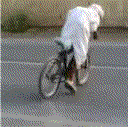Use the Bike as Designed
On the street, you can get away with all sorts of odd ways to use a bike. On the track, we use each part of the bike as it's designed. We slow down with the brakes, speed up with the engine, and keep the clutch out except when shifting.
Brakes are for braking
Most modern bikes on good tires have enough traction to stoppie -- lift the rear wheel from the ground -- under braking. At that point there's no more rapid slowing to be achieved. So the brakes are more than enough to do the slowing down for you.
Not only are the brakes more efficient at slowing the bike, but they're the only method you can really modulate to manage your traction. It's hard to modulate engine braking with the throttle.
That means no engine braking! If you're slowing down, you should be on the brakes. Don't get off the throttle unless you're braking.
Engine is for accelerating
The only thing the engine is intended to do is propel the bike. Forwards. Use it for that, not for a brake.
That doesn't mean pull in the clutch while you're braking. The natural engine braking you get by being off the throttle will help you slow down for the corner without locking the rear wheel. What I do mean is that you don't use engine braking unless you're on the brakes as well.
Clutch is for shifting (down?)
On the street, some riders tend to coast around really tight corners with the clutch in. On the track, that's asking for trouble. When you pull in the clutch, you give up some control over the bike, and that is a very bad thing.
So the only thing you use the clutch for is to shift. Even then, it's a very brief and light tug and release, not a full-blown haul it to the bars and back. Depending on your bike, you'll probably only need the lightest touch on the lever to perform an upshift, and may not need it at all. You will need it for downshifting, but by blipping the throttle to match the revs, you again won't need it all the way in.
Note that when we talk about clutchless shifting, we are not talking about speed shifting, jamming into a higher gear, or anything ham-fisted like that. You ease off the throttle a touch, snick the shifter lightly into gear, and back on the gas. If you need anything more than the lightest "snick" on the shifter, you're not doing it right -- or the bike design won't let you do it easily -- and go back to using the clutch. There really isn't that much to gain by clutchless shifting, so it's not worth spending a lot of effort on learning it.
Pegs are for feet
The footpeg is exactly that, a peg for your foot. It is not supposed to be something to scrape across the ground all the time. While it's usually the first thing on a bike that will touch the ground when you reach the limits of lean angle, it's not supposed to be dragged along the road as a matter of course.
Yes, it looks and feels cool to drag pegs. Yes, Joe Racer uses it as a measure of how well he's cornering. But aside from coolness and street cred, scraping pegs doesn't really serve much purpose.
The reason pegs have feelers is to make sure they're the first thing to touch down. The reason most footpegs are on springs is so they don't lever the bike off the ground when they touch. That doesn't mean they're supposed to be used that way.
Treat scraping the peg as you would a warning light on the dash: it tells you that you leaned too far this time. Ideally you want to have the bike skim along with clear space of half an inch or so between the peg and the road. Any closer than that and you run the risk of a bump -- or imprecise throttle -- bouncing the bike off the road. The peg scraping says, "you got away with it this time." Next time, use less lean angle: take a later apex, so the bike's unwound more to vertical at that point in the road, or slow down so you don't scrape when you flick the bike into the corner.
If you find yourself consistently scraping pegs talk to me and we'll address ways of finding more clearance.
From TrackDoD Novice Group Orientation
Subscribe to:
Post Comments (Atom)



No comments:
Post a Comment